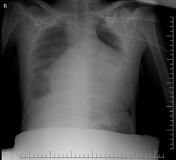Items tagged “heart”
87 results found
Article
Cor triatriatum
Cor triatriatum is an extremely rare and serious congenital cardiac anomaly. It is characterized by the presence of a fibromuscular membrane that divides the left or right atrium into two chambers (depending on the subtype).
Epidemiology
It is thought to account for ~0.1% of all congenital ca...
Case
Dilated cardiomyopathy

Published
18 Sep 2010
52% complete
CT
X-ray
Case
Dilated cardiomyopathy

Published
18 Sep 2010
47% complete
X-ray
Article
Cardiac amyloidosis
Cardiac amyloidosis (plural: amyloidoses) is a significant source of morbidity among patients with systemic amyloidosis and is the most common cause of restrictive cardiomyopathy outside the tropics.
Pathology
Amyloidosis represents the extracellular deposition of insoluble fibrillar proteinac...
Case
Transposition of great arteries

Published
25 Mar 2011
75% complete
X-ray
Article
Fetal bradycardia
Fetal bradycardia refers to an abnormally low fetal heart rate, a potentially ominous finding. A sustained first trimester heart rate below 100 beats per minute (bpm) is generally considered bradycardic. The average fetal heart rate changes during pregnancy, however, and some consider the lower ...
Case
Dilated cardiomyopathy

Published
18 Apr 2011
41% complete
X-ray
Case
Ventricular septal defect - muscular
Published
26 Nov 2011
94% complete
Ultrasound
Article
Atrial escape
Atrial escape refers to a chest x-ray sign of massive left atrial enlargement and is an exaggerated version of the double density sign.
Normally, the right border of the left atrium is not visible. As it enlarges it forms a distinct border projecting through the right heart shadow, medial to ...
Article
Walking man sign (chest x-ray)
The walking man sign is seen on a lateral chest radiograph and is a sign of left atrial enlargement. It results from posterior displacement of the left main bronchus such that it no longer overlaps the right bronchus. The left and right bronchus thus appear as an inverted 'V', mimicking the legs...
Article
Left ventricular aneurysm
Left ventricular aneurysms are discrete, dyskinetic areas of the left ventricular wall with a broad neck (as opposed to left ventricular pseudoaneurysms), thus often termed true aneurysms.
Epidemiology
True left ventricular aneurysms develop in less than 5% of all patients with ST-elevation my...
Article
Pericardial agenesis
Pericardial agenesis is a rare condition where there is the absence of the pericardium to varying degrees. If it is only a small portion of the pericardium that is absent it is known as a pericardial defect.
Epidemiology
According to a surgical and pathological series, the prevalence (inclusiv...
Case
Left atrial enlargement

Published
22 May 2013
68% complete
Barium
Article
Accessory left atrial appendage
An accessory left atrial appendage is a frequent fortuitous finding in cardiac imaging, encountered in ~10% of patients. They are more often seen as a small diverticular structure projecting from the right upper side of the left atrial wall.
Differential diagnosis
it must not be confused with ...
Case
Atrial septal defect

Published
08 Aug 2013
82% complete
X-ray
Case
Takotsubo cardiomyopathy

Published
04 Oct 2013
74% complete
MRI
Case
Restrictive cardiomyopathy - cardiac amyloidosis

Published
07 Oct 2013
71% complete
MRI
Article
Cardiac plexus
The cardiac plexus is a network of autonomic nerves and ganglia situated at the base of the heart. It is formed by cardiac branches derived from both the sympathetic and parasympathetic nervous systems.
Gross anatomy
Parasympathetic cardiac nerves reach the heart from the vagus nerve (cranial ...
Case
Pericardial effusion

Published
11 Jan 2014
82% complete
X-ray
Article
Pulmonary veins
The pulmonary veins drain oxygenated blood from the lungs to the left atrium. A small amount of blood is also drained from the lungs by the bronchial veins.
Gross anatomy
There are typically four pulmonary veins, two draining each lung:
right superior: drains the right upper and middle lobes
...